Perceptual Plasticity in Bilinguals: Language Dominance Reshapes Acoustic Cue Weightings
Abstract
1. Introduction
- To determine whether Spanish–English bilinguals and English monolinguals differ in their reliance on vowel quality, pitch, and duration when perceiving English lexical stress.
- To test whether language dominance predicts individual differences in bilinguals’ cue weighting, with the expectation that English-dominant bilinguals will show greater reliance on vowel quality and reduced reliance on pitch and duration compared to Spanish-dominant bilinguals.
2. Materials and Methods
2.1. Participants
2.2. Materials
2.3. Procedures
2.4. Data Analysis
3. Results
3.1. Vowel Quality by Pitch
3.2. Vowel Quality by Duration
3.3. Pitch by Duration Stimuli
4. Discussion
Supplementary Materials
Author Contributions
Funding
Institutional Review Board Statement
Informed Consent Statement
Data Availability Statement
Acknowledgments
Conflicts of Interest
References
- Tremblay, A.; Broersma, M.; Zeng, Y.; Kim, H.; Lee, J.; Shin, S. Dutch listeners’ perception of English lexical stress: A cue-weighting approach. J. Acoust. Soc. Am. 2021, 149, 3703–3714. [Google Scholar] [CrossRef]
- Luthra, S.; Correia, J.M.; Kleinschmidt, D.F.; Mesite, L.; Myers, E.B. Lexical information guides retuning of neural patterns in perceptual learning for speech. J. Cogn. Neurosci. 2020, 32, 2001–2012. [Google Scholar] [CrossRef]
- Myers, E.B.; Mesite, L.M. Neural systems underlying perceptual adjustment to non-standard speech tokens. J. Mem. Lang. 2014, 76, 80–93. [Google Scholar] [CrossRef] [PubMed]
- Myers, E.B.; Swan, K. Effects of category learning on neural sensitivity to non-native phonetic categories. J. Cogn. Neurosci. 2012, 24, 1695–1708. [Google Scholar] [CrossRef] [PubMed]
- Golestani, N.; Zatorre, R.J. Learning new sounds of speech: Reallocation of neural substrates. Neuroimage 2004, 21, 494–506. [Google Scholar] [CrossRef] [PubMed]
- Luthra, S.; Fuhrmeister, P.; Molfese, P.J.; Guediche, S.; Blumstein, S.E.; Myers, E.B. Brain-behavior relationships in incidental learning of non-native phonetic categories. Brain Lang. 2019, 198, 104692. [Google Scholar] [CrossRef] [PubMed]
- Wu, Y.C.; Viswanathan, V.; Abel, T.J.; Holt, L.L. Auditory cortical responses to speech are shaped by statistical learning of short-term speech input regularities. bioRxiv 2022. [Google Scholar] [CrossRef]
- Lisker, L. “Voicing” in English: A catalogue of acoustic features signaling /b/ versus /p/ in trochees. Lang. Speech 1986, 29, 3–11. [Google Scholar] [CrossRef]
- Holt, L.L.; Lotto, A.J. Cue weighting in auditory categorization: Implications for first and second language acquisition. J. Acoust. Soc. Am. 2006, 119, 3059–3071. [Google Scholar] [CrossRef]
- Francis, A.L.; Baldwin, K.; Nusbaum, H.C. Effects of training on attention to acoustic cues. Percept. Psychophys. 2000, 62, 1668–1680. [Google Scholar] [CrossRef]
- Francis, A.L.; Nusbaum, H.C. Selective attention and the acquisition of new phonetic categories. J. Exp. Psychol. Hum. Percept. Perform. 2002, 28, 349–366. [Google Scholar] [CrossRef]
- Ingvalson, E.M.; McClelland, J.L.; Holt, L.L. Predicting native English-like performance by native Japanese speakers. J. Phon. 2011, 39, 571–584. [Google Scholar] [CrossRef] [PubMed]
- Nosofsky, R.M. Attention, similarity, and the identification–categorization relationship. J. Exp. Psychol. Gen. 1986, 115, 39–57. [Google Scholar] [CrossRef] [PubMed]
- Kuhl, P.K.; Iverson, P. Linguistic experience and the “perceptual magnet effect”. In Speech Perception and Linguistic Experience: Issues In Cross-Language Research; Strange, W., Ed.; York Press: Tomonium, MD, USA, 1995; pp. 121–154. [Google Scholar]
- Chang, C.B. Perceptual attention as the locus of transfer to nonnative speech perception. J. Phon. 2018, 68, 85–102. [Google Scholar] [CrossRef]
- Qin, Z.; Chien, Y.-F.; Tremblay, A. Processing of word-level stress by Mandarin-speaking second language learners of English. Appl. Psycholinguist. 2017, 38, 541–570. [Google Scholar] [CrossRef]
- Choi, W.; Tong, X.; Samuel, A.G. Better than native: Tone language experience enhances English lexical stress discrimination in Cantonese-English bilingual listeners. Cognition 2019, 189, 188–192. [Google Scholar] [CrossRef]
- Zhang, Y.; Francis, A. The weighting of vowel quality in native and non-native listeners’ perception of English lexical stress. J. Phon. 2010, 38, 260–271. [Google Scholar] [CrossRef]
- Chrabaszcz, A.; Winn, M.; Lin, C.Y.; Idsardi, W.J. Acoustic cues to perception of word stress by English, Mandarin, and Russian speakers. J. Speech Lang. Hear. Res. 2014, 57, 1468–1479. [Google Scholar] [CrossRef]
- Kim, H.; Tremblay, A. Korean listeners’ processing of suprasegmental lexical contrasts in Korean and English: A cue-based transfer approach. J. Phon. 2021, 87, 101059. [Google Scholar] [CrossRef]
- Kim, H.; Tremblay, A. Intonational cues to segmental contrasts in the native language facilitate the processing of intonational cues to lexical stress in the second language. Front. Commun. 2022, 7, 845430. [Google Scholar] [CrossRef]
- Tremblay, A.; Broersma, M.; Coughlin, C.E. The functional weight of a prosodic cue in the native language predicts the learning of speech segmentation in a second language. Biling. Lang. Cogn. 2018, 21, 640–652. [Google Scholar] [CrossRef]
- Iverson, P.; Kuhl, P.K.; Akahane-Yamada, R.; Diesch, E.; Tohkura, Y.; Kettermann, A.; Siebert, C. A perceptual interference account of acquisition difficulties for non-native phonemes. Cognition 2003, 87, B47–B57. [Google Scholar] [CrossRef]
- Escudero, P.; Boersma, P. Bridging the gap between L2 speech perception research and phonological theory. Stud. Second. Lang. Acquis. 2004, 26, 551–585. [Google Scholar] [CrossRef]
- Flege, J.E.; Bohn, O.-S.; Jang, S. Effects of experience on non-native speakers’ production and perception of English vowels. J. Phon. 1997, 25, 437–470. [Google Scholar] [CrossRef]
- Escudero, P.; Benders, T.; Lipski, S.C. Native, non-native and L2 perceptual cue weighting for Dutch vowels: The case of Dutch, German, and Spanish listeners. J. Phon. 2009, 37, 452–465. [Google Scholar] [CrossRef]
- Wiener, S.; Goss, S. Second and third language learners’ sensitivity to Japanese pitch accent is additive: An information-based model of pitch perception. Stud. Second Lang. Acquis. 2019, 41, 897–910. [Google Scholar] [CrossRef]
- Bruggeman, L.; Cutler, A. Listening like a native: Unprofitable procedures need to be discarded. Biling. Lang. Cogn. 2023, 26, 1093–1102. [Google Scholar] [CrossRef]
- Schertz, J.; Cho, T.; Lotto, A.; Warner, N. Individual differences in phonetic cue use in production and perception of a non-native sound contrast. J. Phon. 2015, 52, 183–204. [Google Scholar] [CrossRef] [PubMed]
- Bohn, O.-S. Cross-language and second language speech perception. In The Handbook of Psycholinguistics; Fernández, E.M., Cairns, H.S., Eds.; Wiley Blackwell: Hoboken, NJ, USA, 2018; pp. 213–239. [Google Scholar]
- Li, Y.; Lu, J.; Zhang, H.; Wang, C.; Putkinen, V.; Tao, S. Attention moderates the AoA effect on second language vowel perception. J. Neurolinguistics 2025, 75, 101264. [Google Scholar] [CrossRef]
- Norris, D. Perceptual learning in speech. Cogn. Psychol. 2003, 47, 204–238. [Google Scholar] [CrossRef]
- Kraljic, T.; Samuel, A.G. Generalization in perceptual learning for speech. Psychon. Bull. Rev. 2006, 13, 262–268. [Google Scholar] [CrossRef]
- Kraljic, T.; Samuel, A.G. Perceptual adjustments to multiple speakers. J. Mem. Lang. 2007, 56, 1–15. [Google Scholar] [CrossRef]
- Clarke, C.M.; Garrett, M.F. Rapid adaptation to foreign-accented English. J. Acoust. Soc. Am. 2004, 116, 3647–3658. [Google Scholar] [CrossRef]
- Bradlow, A.R.; Bent, T. Perceptual adaptation to non-native speech. Cognition 2008, 106, 709–729. [Google Scholar] [CrossRef]
- Luthra, S.; Luor, A.; Tierney, A.T.; Dick, F.; Holt, L.L. Statistical learning dynamically shapes auditory perception. Npj Sci. Learn. 2025, 10, 41. [Google Scholar] [CrossRef]
- Schertz, J.; Cho, T.; Lotto, A.; Warner, N. Individual differences in perceptual adaptability of foreign sound categories. Atten. Percept. Psychophys. 2016, 78, 355–367. [Google Scholar] [CrossRef]
- Lee, J.; Park, H. Acoustic cue sensitivity in the perception of native category and their relation to nonnative phonological contrast learning. J. Phon. 2024, 104, 101327. [Google Scholar] [CrossRef]
- Dmitrieva, O. Transferring perceptual cue-weighting from second language into first language: Cues to voicing in Russian speakers of English. J. Phon. 2019, 73, 128–143. [Google Scholar] [CrossRef]
- Birdsong, D. Dominance and age in bilingualism. Appl. Linguist. 2014, 35, 374–392. [Google Scholar] [CrossRef]
- Gertken, L.M.; Amengual, M.; Birdsong, D. Assessing language dominance with the Bilingual Language Profile. In Measuring L2 Proficiency: Perspectives from SLA; Leclercq, P., Edmonds, A., Hilton, H., Eds.; Multiliingual Matters: Tonawanda, NY, USA, 2014; pp. 208–225. [Google Scholar]
- Silva-Corvalán, C.; Treffers-Daller, J. (Eds.) Language Dominance in Bilinguals: Issues of Measurement and Operationalization; Cambridge University Press: Cambridge, UK, 2015. [Google Scholar]
- Grosjean, F. Transfer and language mode. Biling. Lang. Cogn. 1998, 1, 175–176. [Google Scholar] [CrossRef]
- Caffarra, S.; Zimnukhova, S.; Mancini, S. What usage can do: The effect of language dominance on simultaneous bilinguals’ morphosyntactic processing. Linguist. Vanguard. 2016, 2, 20160020. [Google Scholar] [CrossRef]
- Gálvez-McDonough, A.F.; Blumenfeld, H.K.; Barragán-Diaz, A.; Anthony, J.J.D.R.; Riès, S.K. Influence of language dominance on crosslinguistic and nonlinguistic interference resolution in bilinguals. Biling. Lang. Cogn. 2025, 28, 648–661. [Google Scholar] [CrossRef]
- Liu, Y.; Ning, J. The effect of language dominance on the selective attention to segments and tones in Urdu-Cantonese speakers. Front. Psychol. 2021, 12, 710713. [Google Scholar] [CrossRef]
- Myers, E.B. Emergence of category-level sensitivities in non-native speech sound learning. Front. Neurosci. 2014, 8, 238. [Google Scholar] [CrossRef] [PubMed]
- Gay, T. Physiological and acoustic correlates of perceived stress. Lang. Speech 1978, 21, 347–353. [Google Scholar] [CrossRef] [PubMed]
- Lindblom, B. Spectrographic study of vowel reduction. J. Acoust. Soc. Am. 1963, 35, 1173–1181. [Google Scholar] [CrossRef]
- Nakatani, L.H.; O’Connor, K.D.; Aston, C.H. Prosodic aspects of American English speech rhythm. Phonetica 1981, 38, 84–106. [Google Scholar] [CrossRef]
- Turk, A.E.; Shattuck-Hufnagel, S. Multiple targets of phrase-final lengthening in American English words. J. Phon. 2007, 35, 445–472. [Google Scholar] [CrossRef]
- Beckman, M.E. Stress and Non-Stress Accents; Foris: Dordrecht, The Netherlands, 1986. [Google Scholar]
- Beckman, M.E.; Pierrehumbert, J. Intonational structure in English and Japanese. Phonol. Yearb. 1986, 3, 255–310. [Google Scholar] [CrossRef]
- Ladd, D.R. Intonational Phonology; Cambridge University Press: Cambridge, UK, 2012. [Google Scholar]
- Pierrehumbert, J. The Phonology and Phonetics of English Intonation. Ph.D. Thesis, Massachusetts Institute of Technology, Cambridge, MA, USA, 1980. [Google Scholar]
- Pierrehumbert, J.; Hirschberg, J. The meaning of intonational contours in the interpretation of discourse. In Intentions in Communication; Cohen, P., Morgan, J., Pollack, M., Eds.; MIT Press: Cambridge, MA, USA, 1990; pp. 271–311. [Google Scholar]
- Beier, E.J.; Ferreira, F. The temporal prediction of stress in speech and its relation to musical beat perception. Front. Psychol. 2018, 9, 431. [Google Scholar] [CrossRef]
- Brown, M.E.; Salverda, A.P.; Dilley, L.C.; Tanenhaus, M.K. Metrical expectations from preceding prosody influence perception of lexical stress. J. Exp. Psychol. 2016, 41, 306–323. [Google Scholar] [CrossRef]
- Cutler, A.; Fox, D.J. On the role of sentence stress in sentence processing. Lang. Speech 1977, 20, 1–10. [Google Scholar] [CrossRef]
- Ortega-Llebaria, M.; Olson, D.J.; Tuninetti, A. Explaining cross-language asymmetries in prosodic processing: The cue-driven window length hypothesis. Lang. Speech 2019, 62, 701–736. [Google Scholar] [CrossRef]
- Choi, W. Theorizing positive transfer in cross-linguistic speech perception: The Acoustic-Attentional-Contextual hypothesis. J. Phon. 2022, 91, 101135. [Google Scholar] [CrossRef]
- Ortega-Llebaria, M.; Wu, Z. Chinese-English speakers’ perception of pitch in their non-tonal language: Reinterpreting English as a tonal-like language. Lang. Speech 2021, 64, 467–487. [Google Scholar] [CrossRef] [PubMed]
- Wang, F.; Deng, D.; Tang, K.; Wayland, R. The effect of pitch accent on the perception of English lexical stress: Evidence from English and Mandarin Chinese listeners. Languages 2024, 9, 87. [Google Scholar] [CrossRef]
- Connell, K.; Hüls, S.; Martínez-García, M.T.; Qin, Z.; Shin, S.; Yan, H.; Tremblay, A. English learners’ use of segmental and suprasegmental cues to stress in lexical access: An eye-tracking study. Lang. Learn. 2018, 68, 635–668. [Google Scholar] [CrossRef]
- Fear, B.D.; Cutler, A.; Butterfield, S. The strong/weak syllable distinction in English. J. Acoust. Soc. Am. 1995, 97, 1893–1904. [Google Scholar] [CrossRef]
- Small, L.H.; Simon, S.D.; Goldberg, J.S. Lexical stress and lexical access: Homographs vs. nonhomographs. Percept. Psychophys. 1988, 44, 272–280. [Google Scholar] [CrossRef] [PubMed]
- Cooper, N.; Cutler, A.; Wales, R. Constraints of lexical stress on lexical access in English: Evidence from native and non-native listeners. Lang. Speech 2002, 45, 207–228. [Google Scholar] [CrossRef]
- Tremblay, A. Is second language lexical access prosodically constrained? Processing of word stress by French Canadian second language learners of English. Appl. Psycholinguist. 2008, 29, 553–584. [Google Scholar] [CrossRef]
- Jesse, A.; Poellmann, K.; Kong, Y.Y. English Listeners Use Suprasegmental Cues to Lexical Stress Early During Spoken-Word Recognition. J. Speech Lang. Hear. Res. 2017, 60, 190–198. [Google Scholar] [CrossRef] [PubMed]
- Hualde, J.I. The Sounds of Spanish; Cambridge University Press: Cambridge, UK, 2005. [Google Scholar]
- Harris, J.W. Syllable Structure and Stress in Spanish: A Nonlinear Analysis; Cambridge University Press: Cambridge, UK, 1983. [Google Scholar]
- Ortega-Llebaria, M.; Prieto, P. Acoustic correlates of stress in Central Catalan and Castilian Spanish. Lang. Speech 2011, 54, 73–97. [Google Scholar] [CrossRef] [PubMed]
- Ortega-Llebaria, M.; Prieto, P. Disentangling stress from accent in Spanish. In Segmental and Prosodic Issues in Romance Phonology; Prieto, P., Mascaró, J., Solé, M.-J., Eds.; John Benjamins Publishing Company: Amsterdam, The Netherlands, 2007; pp. 155–176. [Google Scholar]
- Hualde, J.I.; Prieto, P. Intonational Variation in Spanish: European and American Varieties; Frota, S., Prieto, P., Eds.; Oxford University Press: Oxford, UK, 2015; pp. 350–391. [Google Scholar]
- Face, T.L.; Prieto, P. Rising accents in Castilian Spanish: A revision of Sp_ToBI. J. Port. Linguist. 2007, 6, 117–146. [Google Scholar] [CrossRef]
- Prieto, P.; Torreira, F. The segmental anchoring hypothesis revisited: Syllable structure and speech rate effects on peak timing in Spanish. J. Phon. 2007, 35, 473–500. [Google Scholar] [CrossRef]
- Dupoux, E.; Pallier, C.; Kakehi, K.; Mehler, J. New evidence for prelexical phonological processing in word recognition. Lang. Cogn. Process. 2001, 16, 491–505. [Google Scholar] [CrossRef]
- Dupoux, E.; Pallier, C.; Sebastián, N.; Mehler, J. A destressing “deafness” in French? J. Mem. Lang. 1997, 36, 406–421. [Google Scholar] [CrossRef]
- Dupoux, E.; Sebastián-Gallés, N.; Navarrete, E.; Peperkamp, S. Persistent stress ‘deafness’: The case of French learners of Spanish. Cognition 2008, 106, 682–706. [Google Scholar] [CrossRef]
- Soto-Faraco, S.; Sebastián-Gallés, N.; Cutler, A. Segmental and suprasegmental mismatch in lexical access. J. Mem. Lang. 2001, 45, 412–432. [Google Scholar] [CrossRef]
- Ortega-Llebaria, M.; Gu, H.; Fan, J. English speakers’ perception of Spanish lexical stress: Context-driven L2 stress perception. J. Phon. 2013, 41, 186–197. [Google Scholar] [CrossRef]
- Ortega-Llebaria, M.; Prieto, P. Perception of word stress in Castillian Spanish: The effects of sentence intonation and vowel type. In Phonetics and Phonology: Interactions and Interrelations; Vigáro, M., Frota, S., Freitas, M.J., Eds.; John Benjamins: Amsterdam, The Netherlands, 2009; pp. 35–50. [Google Scholar]
- Kim, J.Y. Discrepancy between heritage speakers’ use of suprasegmental cues in the perception and production of Spanish lexical stress. Biling. Lang. Cogn. 2019, 23, 233–250. [Google Scholar] [CrossRef]
- Kim, J.Y. Relative importance of stress correlates in native listeners’ identification of Spanish lexical stress produced by monolingual and bilingual speakers. J. Phon. 2025, 111, 101418. [Google Scholar] [CrossRef]
- Lee, G.; Shin, D.-J.; Garcia, M.T.M. Perception of lexical stress and sentence focus by Korean-speaking and Spanish-speaking L2 learners of English. Lang. Sci. 2019, 72, 36–49. [Google Scholar] [CrossRef]
- Zhang, J.; Meng, Y.; Wu, C.; Yuan, Z. Spoken word recognition across language boundary: ERP evidence of prosodic transfer driven by pitch. Brain Sci. 2023, 13, 202. [Google Scholar] [CrossRef] [PubMed]
- Braun, B.; Galts, T.; Kabak, B. Lexical encoding of L2 tones: The role of L1 stress, pitch accent and intonation. Second. Lang. Res. 2014, 30, 323–350. [Google Scholar] [CrossRef]
- Weber, A.; Cutler, A. First-language phonotactics in second-language listening. J. Acoust. Soc. Am. 2006, 119, 597–607. [Google Scholar] [CrossRef]
- Tremblay, A.; Spinelli, E. English listeners’ use of distributional and acoustic-phonetic cues to liaison in French: Evidence from eye movements. Lang. Speech 2014, 57, 310–337. [Google Scholar] [CrossRef]
- Minjárez-Oppenheimer, N.I. Investigating the Production and Perception of Lexical Stress in English as a Second Language: A Cue-Weighting Approach. Master’s Thesis, The University of Texas at El Paso, El Paso, TX, USA, 2024. [Google Scholar]
- Birdsong, D.; Gertken, L.M.; Amengual, M. Bilingual Language Profile: An Easy-to-Use Instrument to Assess Bilingualism [Online]. Available online: https://sites.la.utexas.edu/bilingual/ (accessed on 24 October 2022).
- Brown, J.D. Relative merits of four methods for scoring cloze tests. Mod. Lang. J. 1980, 64, 311–317. [Google Scholar] [CrossRef]
- Tremblay, A. Bridging the Gap Between Theoretical Linguistics and Psycholinguistics in L2 Phonology: Acquisition and Processing of English Word Stress by French Canadian L2 Learners. Ph. D. Thesis, University of Hawai’i,, Honolulu, HI, USA, 2007. [Google Scholar]
- Boersma, P.; Weenink, D. Praat: Doing Phonetics by Computer (version 6.0.46) [Computer Program]. 2019. Available online: http://www.praat.org (accessed on 21 May 2021).
- Anwyl-Irvine, A.L.; Massonnié, J.; Flitton, A.; Kirkham, N.; Evershed, J.K. Gorilla in our midst: An online behavioral experiment builder. Behav. Res. Methods 2020, 52, 388–407. [Google Scholar] [CrossRef]
- R: A Language and Environment for Statistical Computing. R Foundation for Statistical Computing: Vienna, Austria, 2024. [Online]. Available online: https://www.R-project.org/ (accessed on 30 May 2025).
- Wickham, H.; Averick, M.; Bryan, J.; Chang, W.; McGowan, L.D.A.; François, R.; Grolemund, G.; Hayes, A.; Henry, L.; Hester, J.; et al. Welcome to the tidyverse. J. Open Source Softw. 2019, 4, 1686. [Google Scholar] [CrossRef]
- Bürkner, P. brms: An R package for Bayesian multilevel models using Stan. J. Stat. Softw. 2017, 80, 1–28. [Google Scholar] [CrossRef]
- Wickham, H. ggplot2: Elegant Graphics for Data Analysis; Springer: New York, NY, USA, 2016. [Google Scholar]
- Flege, J.E.; Bohn, O.-S. The revised Speech Learning Model (SLM-r). In Second Language Speech Learning: Theoretical and Empirical Progress; Wayland, R., Ed.; Cambridge University Press: Cambridge, UK, 2021; pp. 1–83. [Google Scholar]
- Kutlu, E.; Chiu, S.; McMurray, B. Moving away from deficiency models: Gradiency in bilingual speech categorization. Front. Psychol. 2022, 13, 1033825. [Google Scholar] [CrossRef] [PubMed]
- Bayram, F.; Kubota, M.; Luque, A.; Cabo, D.P.Y.; Rothman, J. You can’t fix what is not broken: Contextualizing the imbalance of perceptions about heritage language bilingualism. Front. Educ. 2021, 6, 628311. [Google Scholar] [CrossRef]
- Chang, C.B.; Kwon, S. The contributions of crosslinguistic influence and individual differences to nonnative speech perception. Languages 2020, 5, 49. [Google Scholar] [CrossRef]
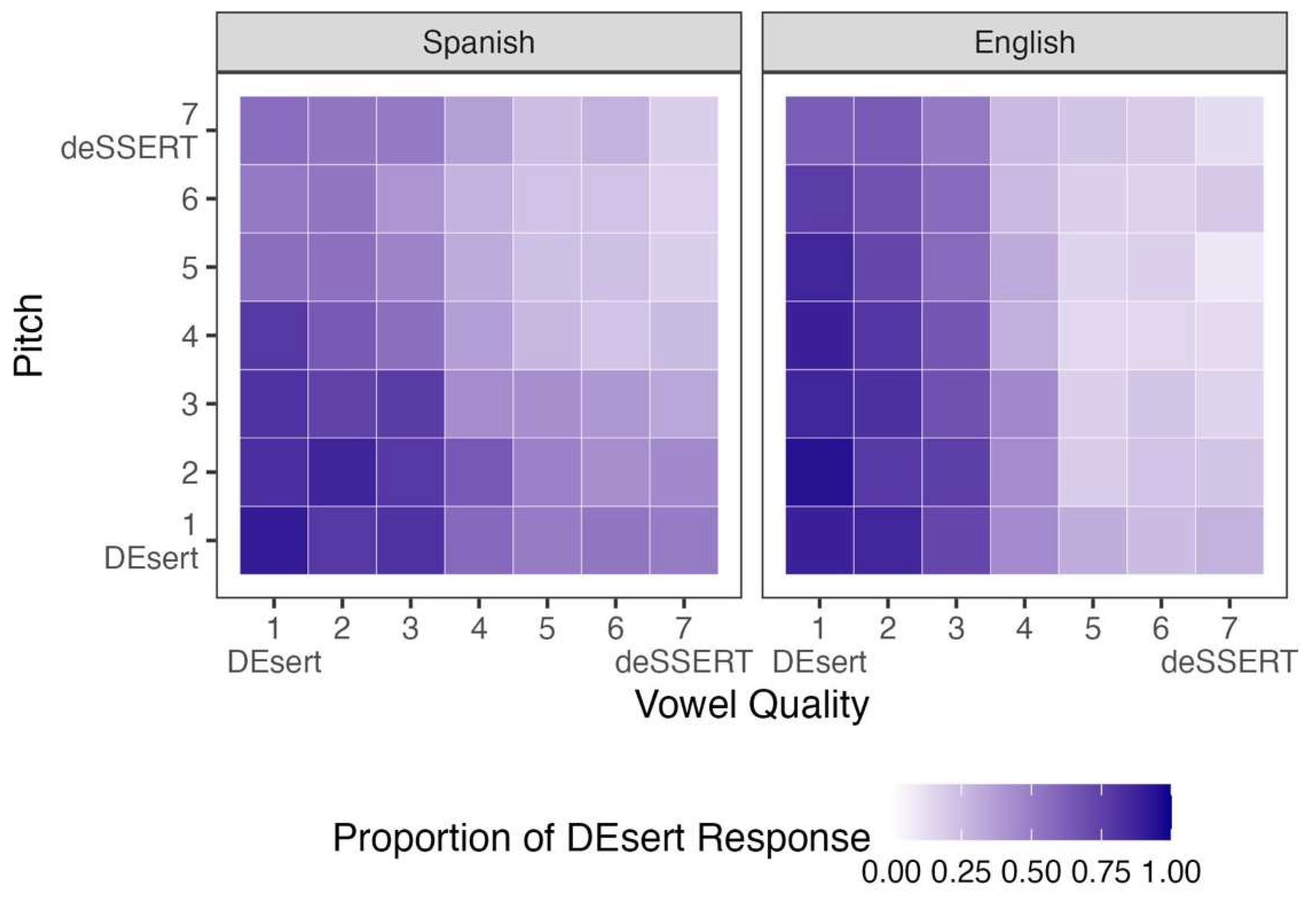

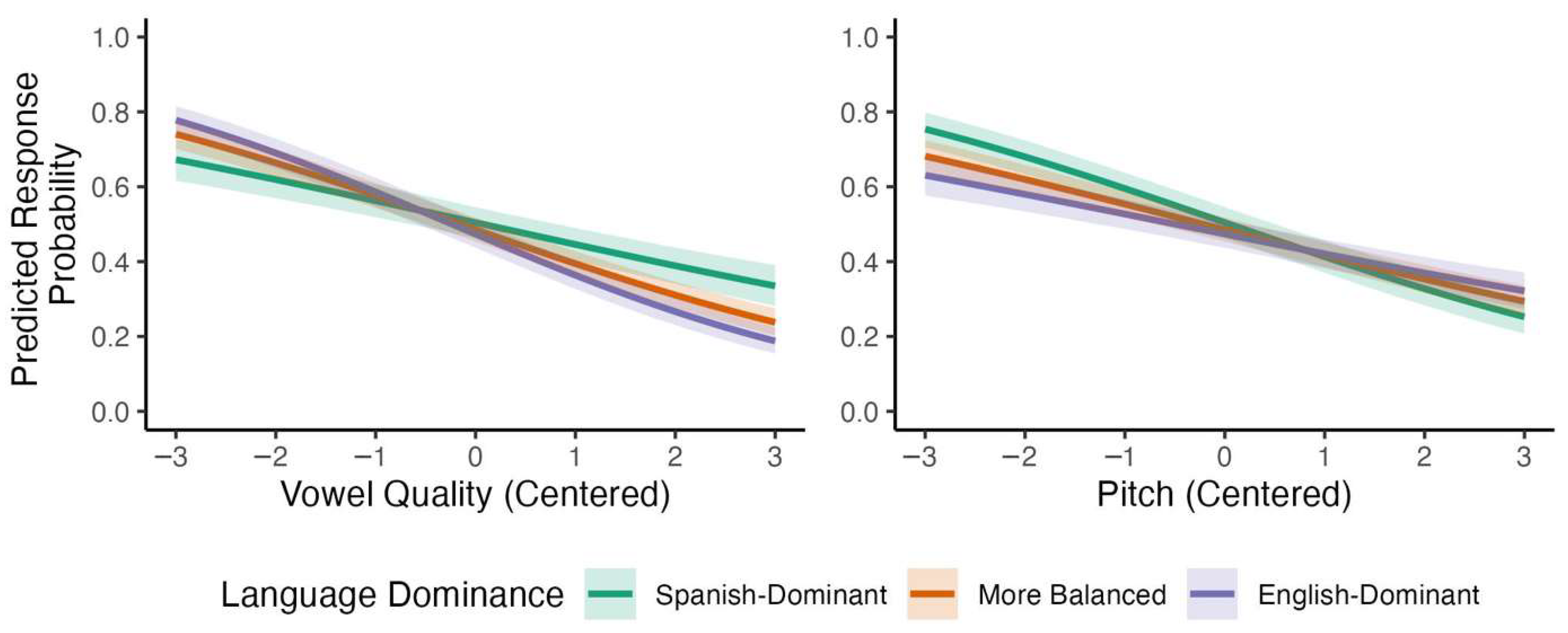

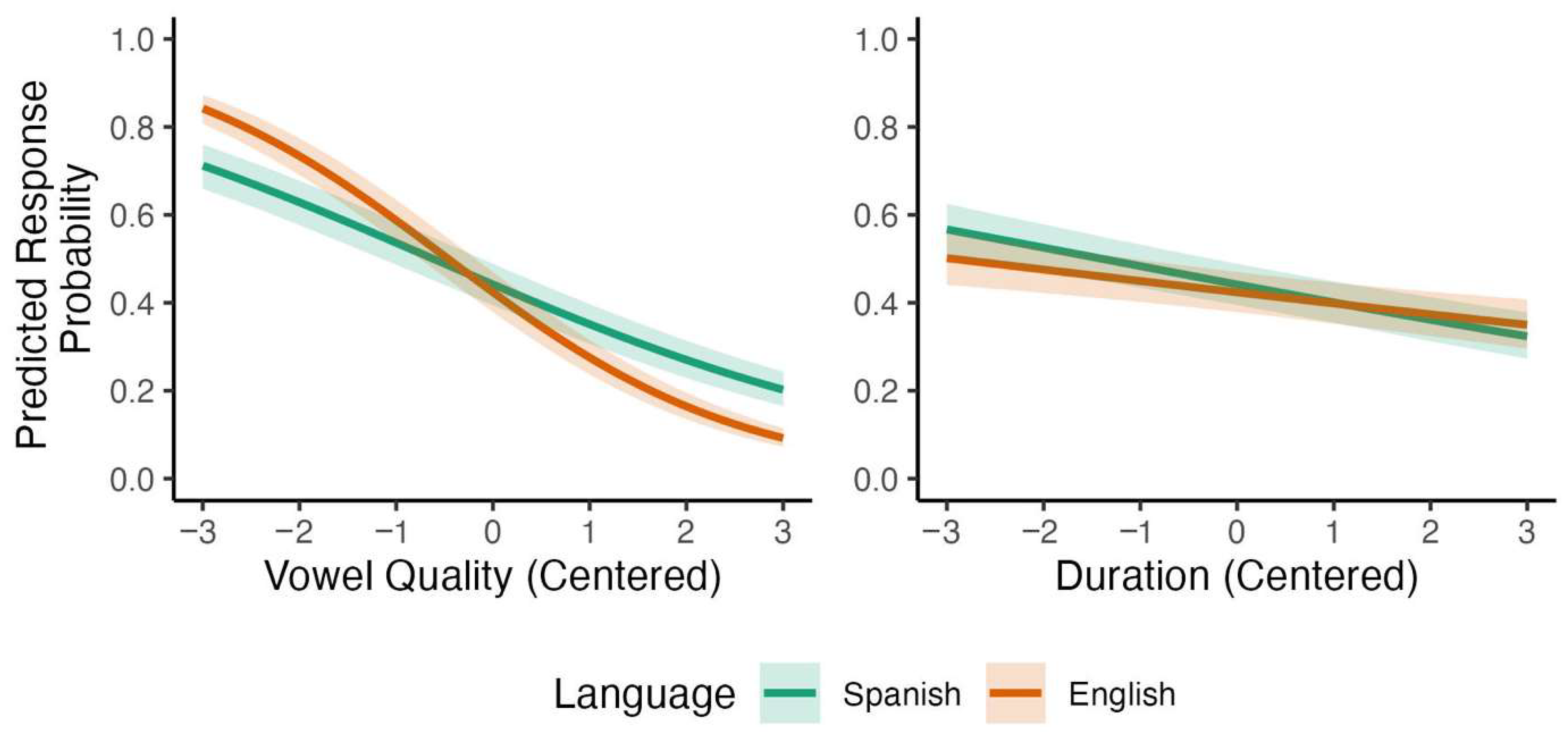

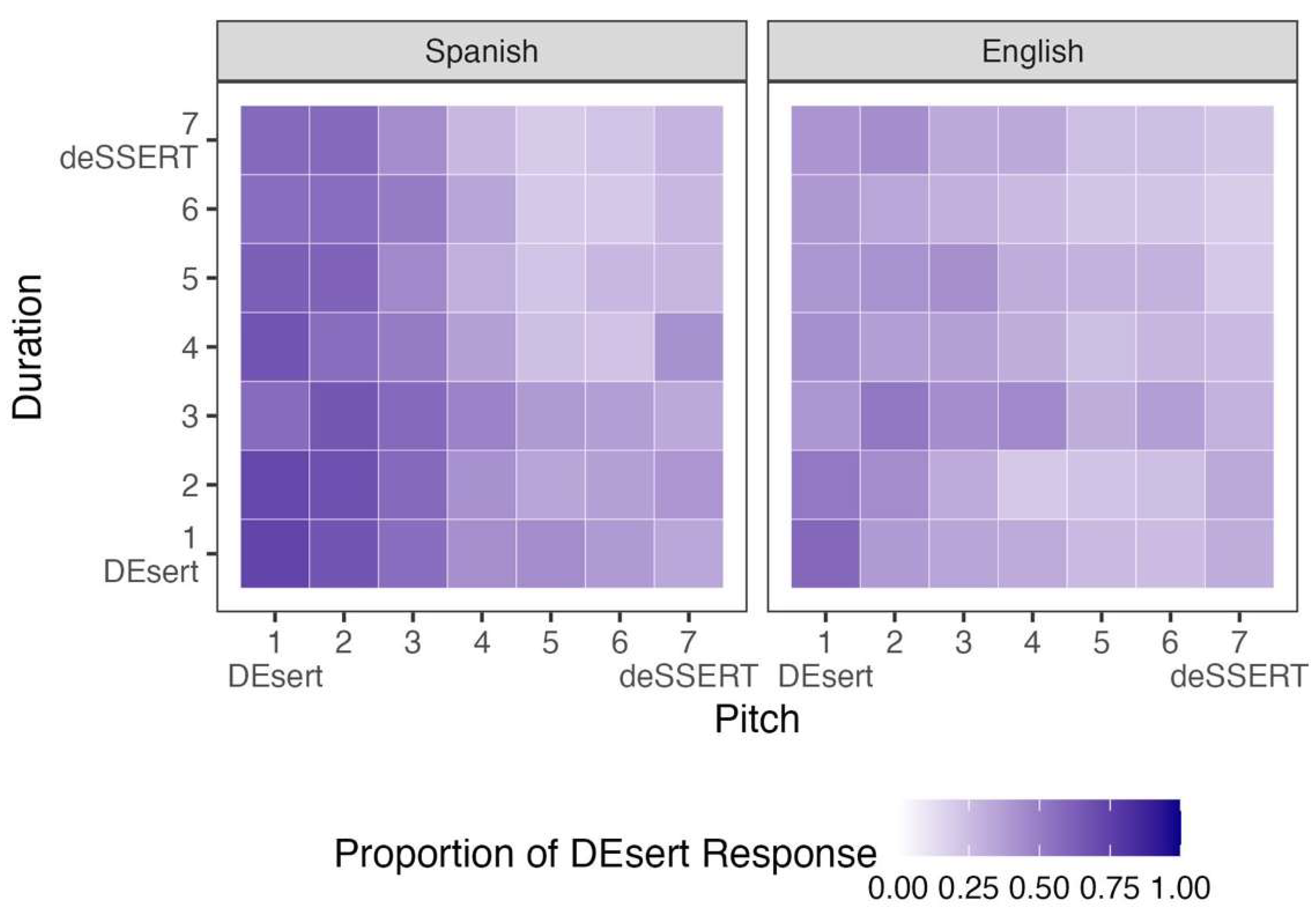
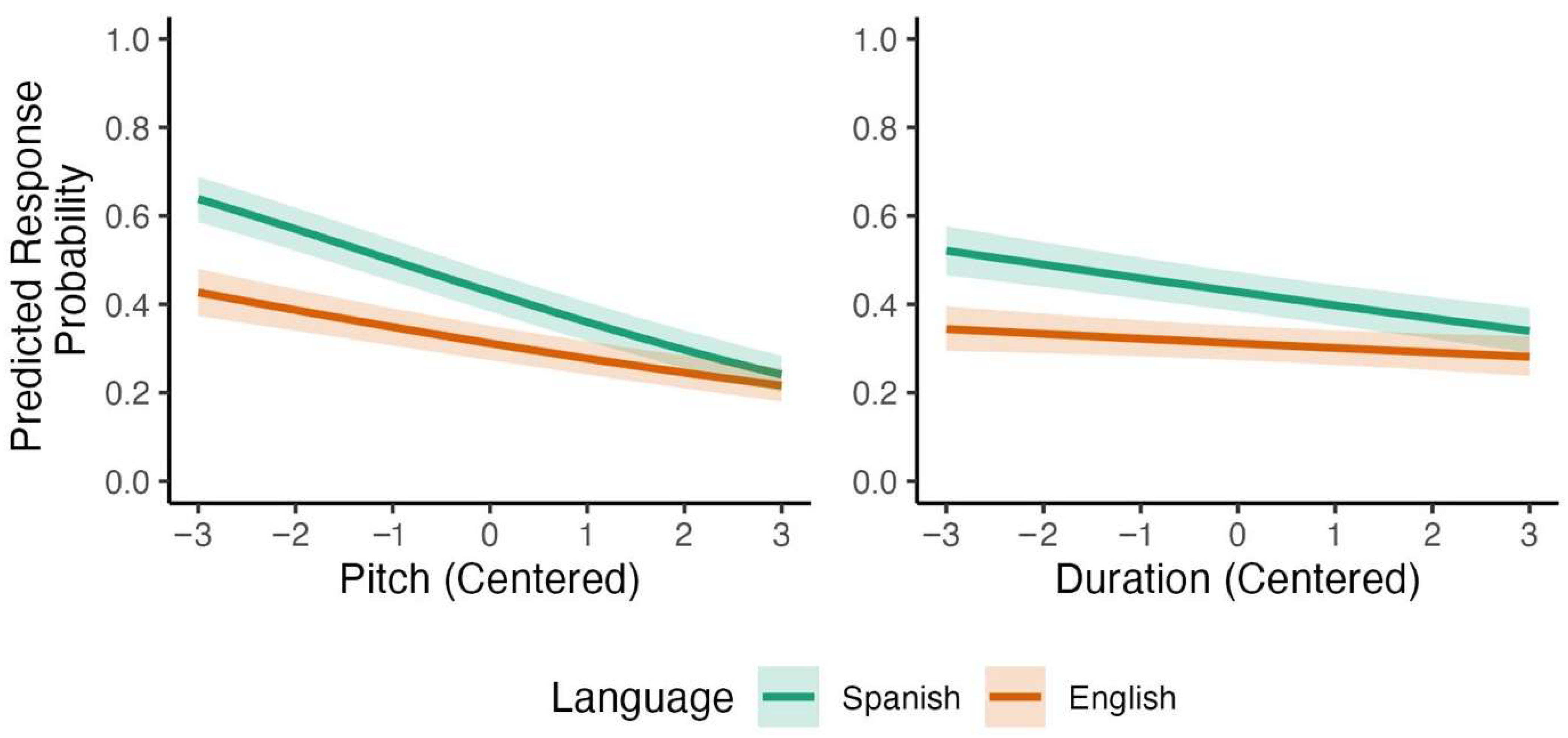

| Spanish | English | |
|---|---|---|
| Age of onset of learning the language | 0.2 (0.5, 0–2) | 6.3 (5.1, 0–18) |
| Age of comfort using the language | 1 (3.4, 0–20) | 9 (6.1, 0–20) |
| Years of classes in the language | 6.8 (6.0, 0–20) | 12.1 (4.4, 3–19) |
| Years spent in Mexico (Spanish) or the US (English) | 7.2 (8.1, 0–24) | 13.7, 9.8, 0–39) |
| % use with friends | 44.6 (32.6, 0–100) | 55.4 (32.6, 0–100) |
| % use with family | 67.4 (30.2, 0–100) | 32.6 (30.2, 0–100) |
| % use at school/work | 28.5 (22.8, 0–80) | 71.5 (22.7, 20–100) |
| % use when you talk to yourself | 43.8 (30.4, 0–100) | 56.2 (30.4, 0–100) |
| % use when counting | 44.9 (37.2, 0–100) | 55.1 (37.2, 0–100) |
| Self-rated listening proficiency (/6) | 5.3 (1.3, 1–6) | 5.6 (0.6, 4–6) |
| Self-rated speaking proficiency (/6) | 4.6 (1.6, 0–6) | 5 (1, 3–6) |
| Self-rated reading proficiency (/6) | 4.6 (1.6, 1–6) | 5.5 (0.8, 3–6) |
| Self-rated writing proficiency (/6) | 3.9 (1.8, 0–6) | 5.2 (1.2, 1–6) |
| Feeling like oneself when speaking the language (/6) | 4.8 (1.7, 0–6) | 4.7 (1.8, 1–6) |
| Identification with language culture (/6) | 4.8 (1.5, 0–6) | 3.9 (1.9, 0–6) |
| Importance of using language like a native speaker (/6) | 5 (1.5, 0–6) | 4.7 (1.5, 0–6) |
| Desire to be perceived as a native speaker (/6) | 4.1 (1.8, 0–6) | 3.4 (2.2, 0–6) |
| DEsert | deSSERT | |||
|---|---|---|---|---|
| First Syllable | Second Syllable | First Syllable | Second Syllable | |
| Duration (ms) | 147 | 216 | 109 | 268 |
| F0 (Hz) | 275 | 208 | 227 | 223 |
| Intensity (dB) | 74 | 70 | 70 | 71 |
| F1 (Hz) | 669 | 556 | 432 | 597 |
| F2 (Hz) | 1845 | 1835 | 1841 | 1703 |
| F3 (Hz) | 2860 | 2242 | 2943 | 2082 |
| Parameter | Posterior Mean | 95% CI (Lower) | 95% CI (Higher) | p (β > 0) | p (β < 0) |
|---|---|---|---|---|---|
| Intercept | −0.053 | −0.193 | 0.088 | 0.233 | 0.767 |
| Vowel Quality | −0.36 | −0.414 | −0.308 | <0.001 | >0.999 |
| Pitch | −0.275 | −0.328 | −0.223 | <0.001 | >0.999 |
| L1 | −0.193 | −0.347 | −0.038 | 0.007 | 0.993 |
| Vowel Quality × Pitch | 0.016 | −0.011 | 0.043 | 0.882 | 0.118 |
| Vowel Quality × L1 (English) | −0.274 | −0.319 | −0.228 | <0.001 | >0.999 |
| Pitch × L1 (English) | 0.116 | 0.073 | 0.159 | >0.999 | <0.001 |
| Vowel Quality × Pitch × L1 (English) | 0.01 | −0.013 | 0.033 | 0.803 | 0.197 |
| Parameter | Posterior Mean | 95% CI (Lower) | 95% CI (Higher) | p (β > 0) | p (β < 0) |
|---|---|---|---|---|---|
| Intercept | −0.227 | −0.412 | −0.04 | 0.009 | 0.991 |
| Vowel Quality | −0.381 | −0.432 | −0.331 | <0.001 | >0.999 |
| Duration | −0.169 | −0.219 | −0.118 | <0.001 | >0.999 |
| L1 | −0.076 | −0.318 | 0.165 | 0.264 | 0.736 |
| Vowel Quality × Duration | 0.025 | −0.001 | 0.05 | 0.972 | 0.028 |
| Vowel Quality × L1 (English) | −0.281 | −0.327 | −0.234 | <0.001 | >0.999 |
| Duration × L1 (English) | 0.064 | 0.019 | 0.108 | 0.998 | 0.002 |
| Vowel Quality × Duration × L1 (English) | −0.022 | −0.045 | 0.001 | 0.029 | 0.971 |
| Parameter | Posterior Mean | 95% CI (Lower) | 95% CI (Higher) | p (β > 0) | p (β < 0) |
|---|---|---|---|---|---|
| Intercept | −0.291 | −0.477 | −0.108 | 0.001 | 0.999 |
| Pitch | −0.287 | −0.328 | −0.244 | <0.001 | >0.999 |
| Duration | −0.125 | −0.166 | −0.084 | <0.001 | >0.999 |
| L1 | −0.508 | −0.752 | −0.264 | <0.001 | >0.999 |
| Pitch × Duration | −0.006 | −0.027 | 0.015 | 0.282 | 0.718 |
| Pitch × L1 (English) | 0.121 | 0.081 | 0.161 | >0.999 | <0.001 |
| Duration × L1 (English) | 0.076 | 0.036 | 0.117 | >0.999 | <0.001 |
| Pitch × Duration × L1 (English) | 0.007 | −0.013 | 0.027 | 0.750 | 0.250 |
Disclaimer/Publisher’s Note: The statements, opinions and data contained in all publications are solely those of the individual author(s) and contributor(s) and not of MDPI and/or the editor(s). MDPI and/or the editor(s) disclaim responsibility for any injury to people or property resulting from any ideas, methods, instructions or products referred to in the content. |
© 2025 by the authors. Licensee MDPI, Basel, Switzerland. This article is an open access article distributed under the terms and conditions of the Creative Commons Attribution (CC BY) license (https://creativecommons.org/licenses/by/4.0/).
Share and Cite
Tremblay, A.; Kim, H. Perceptual Plasticity in Bilinguals: Language Dominance Reshapes Acoustic Cue Weightings. Brain Sci. 2025, 15, 1053. https://doi.org/10.3390/brainsci15101053
Tremblay A, Kim H. Perceptual Plasticity in Bilinguals: Language Dominance Reshapes Acoustic Cue Weightings. Brain Sciences. 2025; 15(10):1053. https://doi.org/10.3390/brainsci15101053
Chicago/Turabian StyleTremblay, Annie, and Hyoju Kim. 2025. "Perceptual Plasticity in Bilinguals: Language Dominance Reshapes Acoustic Cue Weightings" Brain Sciences 15, no. 10: 1053. https://doi.org/10.3390/brainsci15101053
APA StyleTremblay, A., & Kim, H. (2025). Perceptual Plasticity in Bilinguals: Language Dominance Reshapes Acoustic Cue Weightings. Brain Sciences, 15(10), 1053. https://doi.org/10.3390/brainsci15101053






